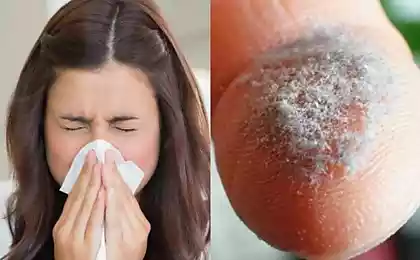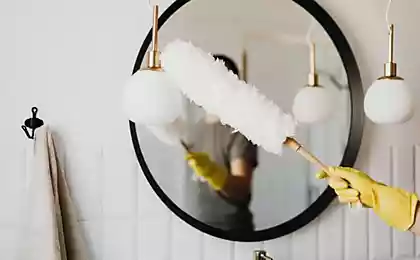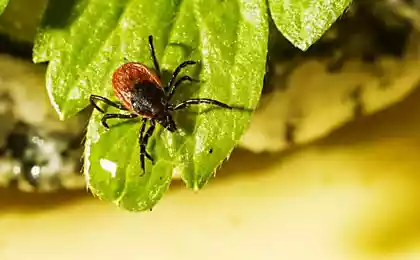338
Dangerous cohabitation: a domestic dust mite
Dust in the apartments appears because they all the time there are some life processes: from the upper layer of human skin (epidermis) peel small particles, pets leave their hair, products dry up, wake up, crumble and also leave small grains. In addition, the dust comes from the outside – its small particles can travel many kilometers before they get to your apartment. Surprisingly, even the waste of penguins living in Antarctica can reach our homes. Thus, a wide variety of particles gather together, mix with air and turn into dust.
Who is a household dust mite?
Dust mites are arachnid insects, ranging in size from 0.1 to 0.5 mm. They live near people all the time, because the most convenient environment for humans is comfortable for these insects. The temperature of 18-25 degrees, humidity from 55% are the most suitable conditions for dust mites. In ordinary house dust, about 150 species are found. They can be seen only at a magnification of 30-40 times, the size is from 250 to 300 microns in length. They don't bite, they don't suck blood.
Nature designed dust mites specifically to recycle the scales of dead human skin, returning them back to nature in the form of original elements. Therefore, in science, these insects are called dermatophagoid or pyrolyphide mites. Within one year, each person loses about 350-400 grams of dead skin, providing food for a huge number of mites.
Mites themselves are safe, but the harm from them is associated with their fecal balls containing strong allergens.
They contain protein enzymes Der f1 and Der p1, as well as antigen P1. It is these substances that can cause severe allergies in people. Weighing less than 0.0002 g, they accumulate in house dust and with it easily rise into the air during cleaning, and do not settle for 10-20 minutes.
Back in 1964, Dutch and Japanese researchers discovered ticks in dust collected in various homes. They caused characteristic inflammation on the skin in patients suffering from allergies to house dust.
House dust mites can cause almost all types of allergies.
The composition includes: library dust (cellulose), fragments of feathers, wool and dandruff of animals, wool fibers, human hair and epidermis, spores of mold and bacteria, particles of insects (cockroaches), cotton, upholstery for furniture, etc.
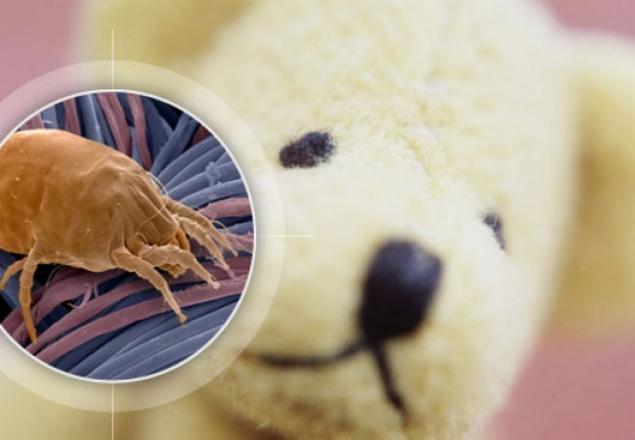
The little villains hypothesis
There is a hypothesis that these little villains came to the human habitation directly from bird nests. With the down and feather of domestic birds, which received them, in turn, from the nests of sparrows and swallows living nearby, mites migrated to our feathers and pillows. In the modern city, ticks continue to settle inside apartments. They settle in hotels, hairdressers, laundry reception points, theaters, feel good on the soft seats of buses, as well as in the dust of mattresses of long-distance trains.
Modern vacuum cleaner is a dangerous "bacterial bomb" in the apartment.
Dust lives in his dust collector. Based on the heat from the engine and the duration of tick accumulation, mold fungi and bacteria multiply over hundreds of generations. When the vacuum cleaner is turned on, they are blown into the air of the room. The typical smell of a vacuum cleaner is actually a warning signal to our immune system. And those who perceive this smell have already inhaled a huge number of poisonous fungi and bacteria.
House dust mites can be divided into three groups:
The first is directly pyrolyphide mites, as well as some types of barn mites.
The second group is predatory ticks that eat the first group.
The third group is random mites that were introduced from the outside, but do not form populations in the apartment and do not reproduce in it.
Dust mites live in "colonies" from 10 to 10 000 insects per 1 gram of dust, the standard concentration of mites is 100 mites per 1 gram, while their population can vary throughout the year - usually the peak of their number in the apartment is the period from August to October. Up to 100 mites per gram of dust - a safe concentration for humans, 500 insects per gram - can provoke an asthmatic attack, and from 1000 to 2000 - cause allergies and chronic runny nose in genetically predisposed people.
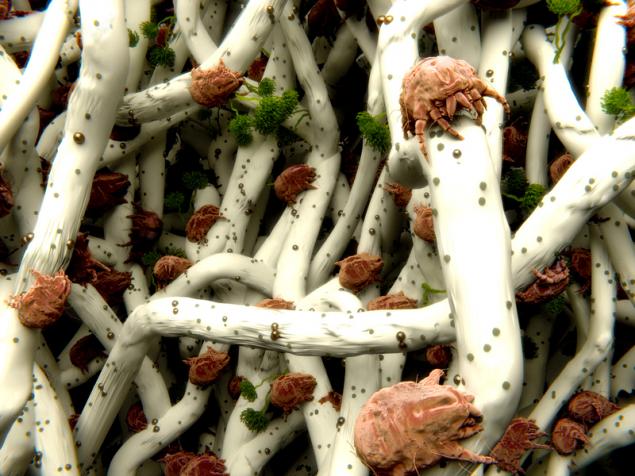
What to do and how to fight?
No one would argue that it is necessary to keep your house and your bed clean, but in the definition of the concept of cleanliness there may be significant differences. If one hostess washes all the floors with disinfectant solution weekly and changes bed linen weekly, the other vacuums a couple of times a month, and clothes for the same month changes once. Both are confident that this is the way to go.
And, interestingly, perhaps both manage to maintain some level of purity. The first has an old apartment and an old sofa, inherited from parents, the second has a new repair and a new bed with a mattress. You know what I mean?
There is no perfect formula for purity. And even if this formula existed, it would not mean total sterility. There is no need to turn the fight against ticks into a war of destruction. No place is empty, who will feed on your dead cells in their absence? There is no doubt that “shit will be sweeter than radish”.
In the villages have long been carried out at least twice a year the procedure of taking out on the street feathers, mattresses, pillows, blankets: dried in the sun in summer and frozen in winter. About ticks then knew nothing, fought mainly with bedbugs and cockroaches. But for mites, this method worked perfectly. Home dust mites do not tolerate ultraviolet light and negative temperatures. Therefore, for the inhabitants of villages and country cottages, this method is good today. Coupled with shaking/knocking out dust – that is, reducing harmful waste products – this procedure will ensure a sufficient level of cleanliness of the bed.
It's harder in town. For a long time in the yards of megacities, they no longer shake out mats and dry clothes. But urban residents are quite capable of keeping the tick population under control. Use stretch covers for bed mattresses and change them together with bed linen, when changing clothes thoroughly vacuum the mattresses themselves, periodically change the position of the top-bottom of the mattress (if they are bilateral). Do not allow the formation of a terry dust carpet under the bed and remove the accumulated dust with a wet cloth or use the wet vacuum cleaner mode (if there is one in your unit, of course).
One last consideration. We spend a third of our lives in bed. And to say the least, it seems strange to me that people buy themselves a jewellery or fur coats, while sleeping on a sofa that their mother gave them. Don't skimp on yourself. How old is the pillow you sleep on? (Is it from my grandmother's dowry? Throw it away without regret! When did you buy yourself a blanket? (Did your parents buy you when they were fifteen and your children are about to graduate from school?) Give this to the dog shelter! How much longer are you going to put off buying a bed and mattress? (Before the third millennium?) It's not even funny.
A new bed and mattress are both new, which, firstly, are free from microorganisms, secondly, give a new impetus to our worldview, not counting the joy of having something pleasant, thirdly, can relieve us of back pain and some chronic ailments. A clean room, a clean bed, clean bedding - and you will not even remember any ticks. That's right.
Studies have shown that about 80% of people with asthma have increased sensitivity to ticks, an important factor in both the development of asthma and its severity. Sensitivity to domestic dust mites is perhaps the most telling example of a health problem caused by changes in the indoor environment. It is almost impossible to get rid of it by conventional means, your house and bed have been its natural habitat for thousands of years, only natural conditions are harmful to it - ozone-rich air, ultraviolet radiation and the natural level of air ionization.
Signs of an Unhealthy Room
Symptoms of this syndrome are fatigue, depression, headaches, asthma, irritation of the mucosa of the eyes, nose and throat, blockage of the nasal and frontal sinuses, skin diseases, allergies and, in the worst cases, malignant tumors. Often poisonous substances contribute to the development in hypersensitive people of additional allergic reactions to dust, home mites, mold spores, pollen and food.
There are a number of general rules that must be followed even before going to an allergist.
All of them are aimed at thorough cleaning of premises and depriving dust mites of the possibility of a comfortable stay in them. So your actions:
Chemicals against dust mites
Allergoff – an acaricide to fight house dust mite
Allergoff is an acaricidal additive to eliminate allergens during washing.
MITE-NIX - a tool for anti-tick processing and elimination of allergens
MITE-NIX - anti-allergenic additive in washing
Milbiol is an anti-tick
Acarex - test for ticks in house dust
Akarosan Spray for processing soft furniture
Acaryl - Acaricide additive in washing
The action of drugs begins immediately after treatment and lasts 30-60 days.
However, when using them, instructions and precautions should be followed. The drugs contain surfactants.
And lastly.
If the owners of a house or apartment do not have symptoms of allergies, this does not mean that dust mites do not live in the premises, they are almost everywhere. The reaction to insect secretions is strictly individual. It can occur when the concentration of parasites in the apartment increases. Therefore, it is imperative to carry out preventive measures aimed at destroying the main mass of the tick. Observing simple rules, you can keep the colony of insects in a healthy size. published
Author: Alyona Bykova
P.S. And remember, just changing our consumption – together we change the world!
Join us on Facebook, VKontakte, Odnoklassniki
Source: /users/14131
Who is a household dust mite?
Dust mites are arachnid insects, ranging in size from 0.1 to 0.5 mm. They live near people all the time, because the most convenient environment for humans is comfortable for these insects. The temperature of 18-25 degrees, humidity from 55% are the most suitable conditions for dust mites. In ordinary house dust, about 150 species are found. They can be seen only at a magnification of 30-40 times, the size is from 250 to 300 microns in length. They don't bite, they don't suck blood.
Nature designed dust mites specifically to recycle the scales of dead human skin, returning them back to nature in the form of original elements. Therefore, in science, these insects are called dermatophagoid or pyrolyphide mites. Within one year, each person loses about 350-400 grams of dead skin, providing food for a huge number of mites.
Mites themselves are safe, but the harm from them is associated with their fecal balls containing strong allergens.
They contain protein enzymes Der f1 and Der p1, as well as antigen P1. It is these substances that can cause severe allergies in people. Weighing less than 0.0002 g, they accumulate in house dust and with it easily rise into the air during cleaning, and do not settle for 10-20 minutes.
Back in 1964, Dutch and Japanese researchers discovered ticks in dust collected in various homes. They caused characteristic inflammation on the skin in patients suffering from allergies to house dust.
House dust mites can cause almost all types of allergies.
- Allergic rhinitis;
- Bronchial asthma;
- Respiratory allergoses - with periodic inhalation of mites and their excrement;
- Atopic dermatitis;
- Conjunctivitis?
- Rhinoconjunctivitis;
- Quincke's edema;
- Acarodermatitis - with bites of dust mites;
- Deep acariasis - when ticks enter the gastrointestinal tract.
The composition includes: library dust (cellulose), fragments of feathers, wool and dandruff of animals, wool fibers, human hair and epidermis, spores of mold and bacteria, particles of insects (cockroaches), cotton, upholstery for furniture, etc.

The little villains hypothesis
There is a hypothesis that these little villains came to the human habitation directly from bird nests. With the down and feather of domestic birds, which received them, in turn, from the nests of sparrows and swallows living nearby, mites migrated to our feathers and pillows. In the modern city, ticks continue to settle inside apartments. They settle in hotels, hairdressers, laundry reception points, theaters, feel good on the soft seats of buses, as well as in the dust of mattresses of long-distance trains.
Modern vacuum cleaner is a dangerous "bacterial bomb" in the apartment.
Dust lives in his dust collector. Based on the heat from the engine and the duration of tick accumulation, mold fungi and bacteria multiply over hundreds of generations. When the vacuum cleaner is turned on, they are blown into the air of the room. The typical smell of a vacuum cleaner is actually a warning signal to our immune system. And those who perceive this smell have already inhaled a huge number of poisonous fungi and bacteria.
House dust mites can be divided into three groups:
The first is directly pyrolyphide mites, as well as some types of barn mites.
The second group is predatory ticks that eat the first group.
The third group is random mites that were introduced from the outside, but do not form populations in the apartment and do not reproduce in it.
Dust mites live in "colonies" from 10 to 10 000 insects per 1 gram of dust, the standard concentration of mites is 100 mites per 1 gram, while their population can vary throughout the year - usually the peak of their number in the apartment is the period from August to October. Up to 100 mites per gram of dust - a safe concentration for humans, 500 insects per gram - can provoke an asthmatic attack, and from 1000 to 2000 - cause allergies and chronic runny nose in genetically predisposed people.

What to do and how to fight?
No one would argue that it is necessary to keep your house and your bed clean, but in the definition of the concept of cleanliness there may be significant differences. If one hostess washes all the floors with disinfectant solution weekly and changes bed linen weekly, the other vacuums a couple of times a month, and clothes for the same month changes once. Both are confident that this is the way to go.
And, interestingly, perhaps both manage to maintain some level of purity. The first has an old apartment and an old sofa, inherited from parents, the second has a new repair and a new bed with a mattress. You know what I mean?
There is no perfect formula for purity. And even if this formula existed, it would not mean total sterility. There is no need to turn the fight against ticks into a war of destruction. No place is empty, who will feed on your dead cells in their absence? There is no doubt that “shit will be sweeter than radish”.
In the villages have long been carried out at least twice a year the procedure of taking out on the street feathers, mattresses, pillows, blankets: dried in the sun in summer and frozen in winter. About ticks then knew nothing, fought mainly with bedbugs and cockroaches. But for mites, this method worked perfectly. Home dust mites do not tolerate ultraviolet light and negative temperatures. Therefore, for the inhabitants of villages and country cottages, this method is good today. Coupled with shaking/knocking out dust – that is, reducing harmful waste products – this procedure will ensure a sufficient level of cleanliness of the bed.
It's harder in town. For a long time in the yards of megacities, they no longer shake out mats and dry clothes. But urban residents are quite capable of keeping the tick population under control. Use stretch covers for bed mattresses and change them together with bed linen, when changing clothes thoroughly vacuum the mattresses themselves, periodically change the position of the top-bottom of the mattress (if they are bilateral). Do not allow the formation of a terry dust carpet under the bed and remove the accumulated dust with a wet cloth or use the wet vacuum cleaner mode (if there is one in your unit, of course).
One last consideration. We spend a third of our lives in bed. And to say the least, it seems strange to me that people buy themselves a jewellery or fur coats, while sleeping on a sofa that their mother gave them. Don't skimp on yourself. How old is the pillow you sleep on? (Is it from my grandmother's dowry? Throw it away without regret! When did you buy yourself a blanket? (Did your parents buy you when they were fifteen and your children are about to graduate from school?) Give this to the dog shelter! How much longer are you going to put off buying a bed and mattress? (Before the third millennium?) It's not even funny.
A new bed and mattress are both new, which, firstly, are free from microorganisms, secondly, give a new impetus to our worldview, not counting the joy of having something pleasant, thirdly, can relieve us of back pain and some chronic ailments. A clean room, a clean bed, clean bedding - and you will not even remember any ticks. That's right.
Studies have shown that about 80% of people with asthma have increased sensitivity to ticks, an important factor in both the development of asthma and its severity. Sensitivity to domestic dust mites is perhaps the most telling example of a health problem caused by changes in the indoor environment. It is almost impossible to get rid of it by conventional means, your house and bed have been its natural habitat for thousands of years, only natural conditions are harmful to it - ozone-rich air, ultraviolet radiation and the natural level of air ionization.
Signs of an Unhealthy Room
Symptoms of this syndrome are fatigue, depression, headaches, asthma, irritation of the mucosa of the eyes, nose and throat, blockage of the nasal and frontal sinuses, skin diseases, allergies and, in the worst cases, malignant tumors. Often poisonous substances contribute to the development in hypersensitive people of additional allergic reactions to dust, home mites, mold spores, pollen and food.
There are a number of general rules that must be followed even before going to an allergist.
All of them are aimed at thorough cleaning of premises and depriving dust mites of the possibility of a comfortable stay in them. So your actions:
- Reduce the amount of upholstered furniture with woven upholstery, replacing it with upholstered furniture made of leather or its substitute;
- Ruthlessly get rid of all wool carpets, as well as carpets and rugs with high and / or natural pile;
- Getting rid of soft toys;
- Replace down and feather bedding (pillows and blankets) with synthetic ones;
- Arrange a hot wash of all bedding and then thoroughly dry them in the air (balcony, loggia or kitchen with an open window);
- Do wet cleaning of the floor and boards with salt solution, which is prepared at the rate of 5-10 tablespoons per bucket of water;
- Wipe with a wet napkin all the books on the shelves and pour boiling water on all the dishes standing in the sideboard;
- Remove all hard-to-reach places with a vacuum cleaner with an aquafilter and a separator with a HEPA filter;
- Maintain a dry microclimate in the apartment with humidity below 40% for a month, you can use dehumidifiers for this;
- Use air conditioners and air purifiers that can trap particles less than 30 microns
Chemicals against dust mites
Allergoff – an acaricide to fight house dust mite
Allergoff is an acaricidal additive to eliminate allergens during washing.
MITE-NIX - a tool for anti-tick processing and elimination of allergens
MITE-NIX - anti-allergenic additive in washing
Milbiol is an anti-tick
Acarex - test for ticks in house dust
Akarosan Spray for processing soft furniture
Acaryl - Acaricide additive in washing
The action of drugs begins immediately after treatment and lasts 30-60 days.
However, when using them, instructions and precautions should be followed. The drugs contain surfactants.
And lastly.
If the owners of a house or apartment do not have symptoms of allergies, this does not mean that dust mites do not live in the premises, they are almost everywhere. The reaction to insect secretions is strictly individual. It can occur when the concentration of parasites in the apartment increases. Therefore, it is imperative to carry out preventive measures aimed at destroying the main mass of the tick. Observing simple rules, you can keep the colony of insects in a healthy size. published
Author: Alyona Bykova
P.S. And remember, just changing our consumption – together we change the world!
Join us on Facebook, VKontakte, Odnoklassniki
Source: /users/14131

















